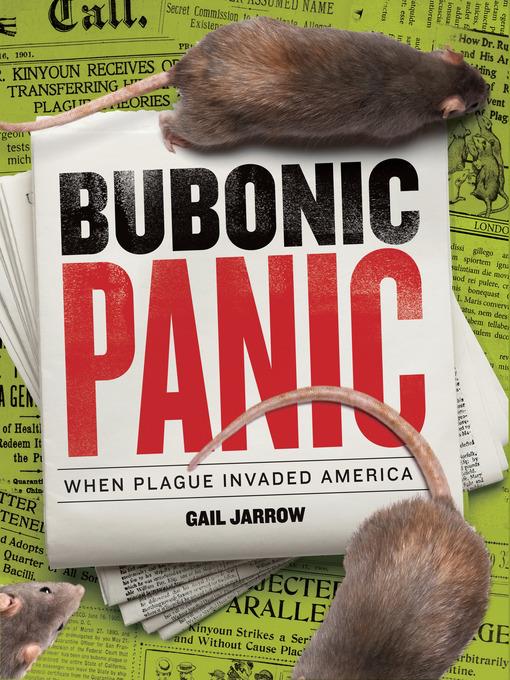
Bubonic Panic
When Plague Invaded America
فرمت کتاب
ebook
تاریخ انتشار
2016
Lexile Score
1000
Reading Level
5-7
ATOS
7.7
Interest Level
4-8(MG)
نویسنده
Gail Jarrowشابک
9781629795621
کتاب های مرتبط
- اطلاعات
- نقد و بررسی
- دیدگاه کاربران
نقد و بررسی

February 1, 2016
Gr 5 Up-With a mesmerizing description of the suffering endured by bubonic plague victims, followed by several fascinatingly gruesome photographs depicting visible signs of the disease, Jarrow hooks readers from the start. This final installment of the author's "Deadly Disease" trilogy is as compelling as the first two titles, Red Madness: How a Medical Mystery Changed What We Eat (2014) and Fatal Fever: Tracking Down Typhoid Mary (2015, both Boyds Mills). Before describing the chaos the plague wrought on American shores, Jarrow recounts major plague outbreaks throughout history as well as early bacteriological advances, such as the identification by French scientist Alexandre Yersin of the microbe responsible for the bubonic plague. The plague arrived in the port city of San Francisco in 1900 and claimed its first victim in Chinatown, a neighborhood near the wharves. Chinatown was quickly quarantined by the Board of Health, but with California Governor Henry T. Gage denying the existence of plague and Chinese officials bucking against perceived discrimination, tensions rose and containment efforts failed. Eventually Rupert Blue of the Marine-Hospital Service was brought in by the surgeon general to control the outbreak. When the plague returned to San Francisco in 1907 after the devastating earthquake of 1906, Blue came back. By this time scientists had determined that the fleas on rats were responsible for transmitting the plague, and the city mobilized to curtail the rat population, successfully containing the outbreak in a matter of months. Weaving in numerous photographs and newspaper clippings, Jarrow tells an absorbing story. VERDICT Nonfiction that reads like a thriller-not to be missed.-Ragan O'Malley, Saint Ann's School, Brooklyn, NY
Copyright 2016 School Library Journal, LLC Used with permission.

Starred review from May 23, 2016
Jarrow concludes her Deadly Diseases trilogy (after Red Madness and Fatal Fever) with a harrowing, in-depth exploration of the reappearance of bubonic plague at the turn of the 20th century. After briefly detailing earlier outbreaks of plague, Jarrow focuses on the Third Pandemic, which began in 1880s China before spreading to India, Hawaii, San Francisco, and beyond. Augmented by archival illustrations and photographs (including some gruesome ones showing the effects of the plague), her gripping narrative balances the clock-racing work of scientists and officials attempting to understand and stop the plague with entwined themes of fear, prejudice, and anger (“San Francisco’s Chinese population had been unlucky enough to live near the harbor where plague entered the city”). Extensively researched, with numerous resources for readers looking to study the topic further. Ages 10–up.

Starred review from February 15, 2016
Following Fatal Fever (2015) and Red Madness (2014), Jarrow explores America's experience with the bubonic plague. A devastating pandemic that started in Asia found its way to California in 1900, and Chinese immigrants in San Francisco were the first to fall victim. Efforts to stem the disease were led by the U.S. Marine-Hospital Service (later the U.S. Public Health Service). Suspicion and fear of discrimination among Chinatown residents and the reluctance of state and local political figures to acknowledge the outbreak initially held back progress. Changes in medical and political leadership brought about more success, until the San Francisco earthquake and unsanitary conditions in its wake led to the plague's return. Jarrow's detailed narrative and attention to the stories of the medical figures involved make this compelling reading. As in the previous volumes, the level of research on display is impressive, notably Jarrow's close look at what has been learned about the rats and fleas that spread the disease and her smooth integration of social and medical factors into her discussion. The large number of photographs and illustrations enhances the text, and the layout is graphically interesting without becoming distracting. The interesting truth that the disease can still be contracted is among additional facts included in a FAQ section at the book's conclusion. A richly detailed exploration of a fascinating subject. (glossary, timeline, further resources, author's note, bibliography, source notes, picture credits, index) (Nonfiction. 10-18)
COPYRIGHT(2016) Kirkus Reviews, ALL RIGHTS RESERVED.

March 1, 2016
Grades 6-9 If the term bubonic plague conjures up images of medieval Europe, this disquieting book will shift your frame of reference a little closer to home: San Francisco in the early 1900s. Jarrow looks at plague throughout history and medical research into its causes, before zeroing in on its resurgence in the late nineteenth century, when it arose in Asia and reached Honolulu. She offers a detailed portrayal of its medical and social consequences when it struck in California, initially in San Francisco's Chinatown. Thoroughly researched and clearly presented, the text offers a direct window into the period. The intertwined themes of prejudice against Asian Americans, public health officials hampered by politicians, and mistrust of scientific research (which indicated that fleas carried plague from rodents to humans) make the story complex, revealing a good deal about human nature as well as the period and the disease itself. In addition to the many well-chosen period photos and prints, the illustrations include a few color photos of plague-ridden bodies. An informative book on an unusual topic.(Reprinted with permission of Booklist, copyright 2016, American Library Association.)

























دیدگاه کاربران